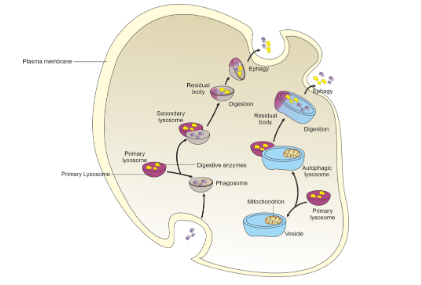Table of Contents
Lysosomes are fascinating and vital organelles found in eukaryotic cells. They play a crucial role in cell recycling and degradation processes, maintaining cellular health, and regulating various cellular activities.
What is a Lysosome?
Lysosomes are membrane-bound organelles. They are responsible for breaking down waste materials, cellular debris, and foreign substances through enzymatic degradation. Lysosomes act as cellular recycling centers, ensuring the renewal and maintenance of cellular components.
Structure of Lysosomes
Lysosomes have a spherical shape and contain hydrolytic enzymes, including proteases, lipases, nucleases, and carbohydrates, among others. These enzymes are highly acidic, maintaining the pH of lysosomes at around 4.5 to 5.0, which is crucial for their optimal functioning.
Various types of Lysosomes
Lysosomes can be classified into several types based on their developmental and functional stages.
Primary Lysosomes
Primary lysosomes are newly formed lysosomes that contain inactive hydrolytic enzymes. These enzymes are synthesized in the endoplasmic reticulum and then transported to the Golgi apparatus, where they are packaged into vesicles that mature into primary lysosomes. These lysosomes have a neutral to slightly acidic pH.
Secondary Lysosomes
Secondary lysosomes are formed by the fusion of primary lysosomes with endocytic vesicles containing materials from outside the cell. When primary lysosomes fuse with endosomes, their contents mix, and the hydrolytic enzymes become active due to the acidic environment of the endosome. This activation allows the enzymes to degrade the contents of the endocytic vesicles.
Autolysosomes
Autolysosomes are formed by the fusion of lysosomes with autophagosomes. Autophagosomes are membrane-bound vesicles that engulf and transport damaged organelles or cellular components for degradation. The fusion of lysosomes with autophagosomes forms autolysosomes, where the cellular material is broken down and recycled.
Residual Bodies
Residual bodies are lysosomes containing indigestible materials that cannot be broken down by hydrolytic enzymes. These materials accumulate over time and are often remnants of degraded organelles or lipids that are resistant to degradation. Residual bodies are more commonly seen in aged or senescent cells.
Heterophagosomes
Heterophagosomes are formed when lysosomes fuse with vesicles containing extracellular materials acquired through processes like phagocytosis or pinocytosis. The hydrolytic enzymes in the lysosomes degrade the engulfed materials, facilitating nutrient absorption and cellular processes.

Why Are Lysosomes Called “Suicide Bags”?
Lysosomes are nicknamed because if they rupture or leak their contents into the cytoplasm, the hydrolytic enzymes can destroy cellular structures and cause cell death. However, under normal conditions, lysosomes maintain their integrity and function safely within cells.
How Do Lysosomes Function?
Lysosomes receive materials for degradation through endocytosis, phagocytosis, or autophagy. They fuse with vesicles carrying foreign particles, worn-out organelles, or macromolecules, forming endosomes. The acidic environment inside lysosomes activates the hydrolytic enzymes, breaking down the contents into simpler molecules for recycling or excretion.
Frequently Asked Questions on Lysosomes
What are lysosomes?
Lysosomes are membrane-bound organelles found in eukaryotic cells. They contain hydrolytic enzymes responsible for breaking down waste materials, cellular debris, and foreign substances through enzymatic degradation.
Where are lysosomes located in the cell?
Lysosomes are typically located throughout the cytoplasm of animal cells. They are membrane-bound vesicles that fuse with endocytic vesicles or autophagosomes to facilitate degradation.
What is the pH of lysosomes?
Lysosomes have an acidic environment, with a pH range of approximately 4.5 to 5.0. This low pH is essential for activating the hydrolytic enzymes and ensuring efficient degradation.
What is the function of lysosomes in the cell?
The main function of lysosomes is to degrade and recycle cellular waste, damaged organelles, and foreign materials. They play a vital role in maintaining cellular health and homeostasis.
How do lysosomes carry out their functions?
Lysosomes receive materials for degradation through processes like endocytosis, phagocytosis, and autophagy. Once fused with appropriate vesicles (endosomes or autophagosomes), lysosomes release their hydrolytic enzymes, which break down the contents into simpler molecules for recycling or excretion.









